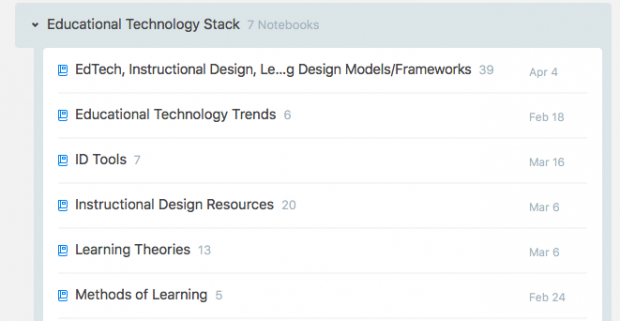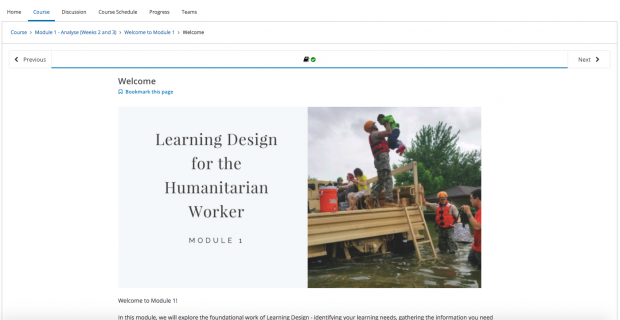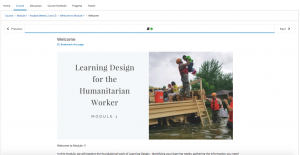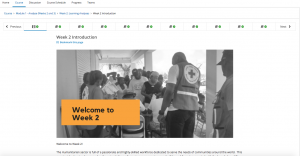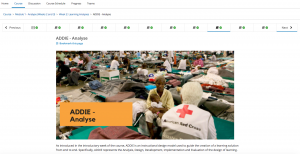At the beginning of this course, I talked about my desire to learn about contextualising learning experiences to address the needs of diverse populations as my primary goal. Within this, I wanted to learn about selecting and employing technologies that can support communities of practice, using mobile technologies effectively, the appropriateness of using Learning Management Systems (LMSs) in the present and the future, and how to leverage learning technologies to embed a culture of learning and feedback within organisations.
Throughout the course I’ve been able to address various dimensions of these questions through the course activities, but I was also able to leverage the life changes I was going through to think about what I was learning in a different way. Over the duration of the course, from a professional context, I completed my role at the Commonwealth of Learning (COL) in Vancouver to move to the UK and explore other professional opportunities. At COL, I rolled out a technology-enabled learning project for marginalised women and girls in developing Commonwealth countries to tackle issues of gender inequality. My passion for the role of education in this context inspired me to explore ETEC 565A and reflect on learning technologies that would effectively support the education of a learner group who live in remote areas and who face multiple barriers to educational access. Over the duration of the course, my priorities started to include what the UK has to offer and how I can put my learnings from MET to tangible use in a different professional context so I can strengthen my foundations on educational technology. I thought about the various career paths such as instructional and learning design, managing learning projects including digital learning, people development in organisations, facilitating capacity building opportunities in various contexts. This new perspective allowed me to rethink and again reflect on the course and see the course learnings from a different angle and from different stakeholder/learner groups.
Thinking about the frameworks that the course offered, such as the SECTIONS model presented by Bates (2014), allowed me to learn about the various considerations about choosing media such as the learners’ context, ease of use, organisational issues, costs etc. In particular, I was able to apply this to the project at COL – for example, in the process of building an educational game to enhance girls’ life skills training on their legal rights, I was able to ask questions such as ‘what medium would allow this game to be replicated in different geographical contexts, what technologies do the girls and their tutors currently have access to?’. I was also able to apply the seven principles of technology as a lever in education offered by Chickering (1996). In enhancing the community of practice (CoP) of NGO workers at COL, I was able to reflect on how to improve on several good practices such as giving prompt feedback, communicating expectations, recognising diverse talents and ways of learning and absorbing information, and using active learning techniques. In my 1-1 and group interactions with members of the CoP, I was able to employ these principles and see each of them for their unique characteristics as learners, but also find ways to enhance interaction between the other members of the CoP and the different project stakeholders.
Chickering’s model led me to also reflect on Andersen’s framework (2008) on effective learning from a community, knowledge, learner and assessment centred perspectives. More importantly, I was able to think about the various types of interaction and what this means for selecting/enhancing the use of learning technologies. In a concrete way, I was able to think about learning interaction between: learner-learner, learner-facilitator, learner-content. Most recently, over the last week, in a job interview for a Digital Learning Project Manager role, I was tasked with presenting on solutions to a challenge on low learner engagement where I used Andersen’s framework for interaction as a basis to think of solutions. I was able to ask myself questions such as, ‘what type of learning solutions could enhance learner’s interaction with each other, with the platform and with the content to increase engagement?’. In a different job interview for a Learning Designer role, I was given two hours to re-design the assessment for a MOOC, and in this context, I was able to apply what I’ve learned about formative and summative assessment strategies, and particularly consider how learners choose to interact with the course based on these assessment strategies.
Having a solid understanding of the various frameworks, I was able to also think of myself from the learner perspective for different topics offered in the course. For example: how does social media enhance my learning? How do I learn on the go, and how do my mobile devices assist me in this learning process? How do I think of approach my learning upon knowing about the assessment strategies of that learning opportunity? These questions allowed me to put myself in the shoes of others who would be on the receiving end of the learning projects I’m involved with. The discussion forums in the course also aided this process. For example, being able to experience three different types of learner discussions in the course was helpful. I was able to reflect on the ease and effectiveness of small group discussion forums, course wide discussions and chat-based discussions such as experimented on Mattermost. These different types of interactions exposed me to the advantages and disadvantages and would put me in a better position to emphathise with different learner groups that I would be involved with in future.
The course assignments also advanced my understanding of course concepts, and allowed me to explore beyond the ‘walls’ of the course based on my interests and life circumstances. For example, the LMS rubric group assignment allowed me to put to use my practical experience with different LMSs but also think about learner interaction and context from a different perspective: how do learners choose to access a platform, what is their motivation to do so, what would enhance their experience, what are the implications on the structure, cost and organisation? This assignment allowed me to have a more informed perspective on the subsequent assignments on designing my own course on a chosen platform. I had chosen edX as I was curious on how the MOOC movement will carry on and I wanted to gain an insider perspective from a course developer standpoint. I was also curious as a MOOC learner on the intricacies of course design and how this affects my experience and engagement as a learner joined my thousands of others around the world. I had chosen to design a course on Learning Design for the Humanitarian Worker which proved to be extremely (!) useful for many reasons. First, it pushed me to solidify my understanding of Learning Design from MET. In this process, I actually signed up for an edX MOOC from the University of Maryland on Instructional Design to refresh my memory and also compare the frameworks I had learned throughout MET. This was a useful exercise and provided me the confidence to ‘own what I already know’. Second, I was able to employ different frameworks that I was exposed to before in MET, such as Understanding by Design (UBD) – Backward Design approach and Bloom’s Taxonomy for designing Learning Outcomes. Third, I was able to intimately familiarise myself with the ADDIE model, which proved repeatedly useful in job interviews. And finally, I was able to reflect on the humanitarian sector in a different way – it further ignited my passion for the work but also reflect on the needs of my colleagues around the world.
Overall, I have found this course so useful and transforming – professionally and personally. I was really able to leverage this course in a real-word context, and I appreciated the flexibility it offered to make it as relevant to my life circumstances as possible. I was able to explore resources within this course and was encouraged to explore beyond as well, that gave me the confidence to apply it to my immediate professional needs. Using my Evernote, I have made an Educational Technology ‘notebook’ (see screenshot) with lots of bookmarks and resources coming from this course and beyond! Going forward, I had made extensive notes of what I have learned here, and I plan to keep going back to these notes as I’m sure the learnings are timeless, regardless of the professional journey within education I choose to take. Within the past 3-4 months, I have already used my learnings here, and I am certain that I will be using this more times than I realise throughout my career, and hopefully deliver the most effective learning solutions to the learners I serve.
References
Anderson, T. (2008a). Towards a theory of online learning. In T. Anderson & F. Elloumi (Eds.), Theory and practice of online learning. Edmonton AB: Athabasca University. Retrieved from http://www.aupress.ca/books/120146/ebook/02_Anderson_2008-Theory_and_Practice_of_Online_Learning.pdf
Bates, T. (2014). Choosing and using media in education: The SECTIONS model. In Teaching in digital age. Retrieved from https://opentextbc.ca/teachinginadigitalage/part/9-pedagogical-differences-between-media/
Chickering, A. W., & Ehrmann, S., C. (1996). Implementing the seven principles: Technology as lever. American Association for Higher Education Bulletin, 49(2), 3-6. Retrieved from http://www.aahea.org/articles/sevenprinciples.htm
